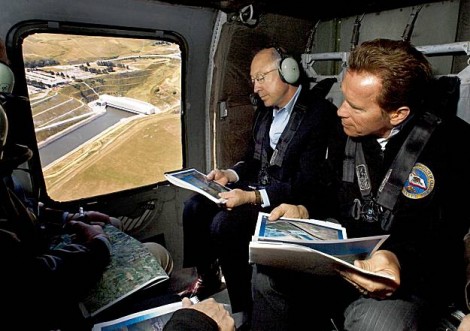
This story was first published on Alternet.org

“That, in your own backyard there, is the scariest place after New Orleans.”
—Geologist Nicholas Pinder’s description of the precarious situation in the Sacramento-San Joaquin River Delta after the hurricane Katrina disaster.
Imagine the devastating flooding of Hurricane Katrina multiplied by epic sandstorms, drought and economic collapse of the Dust Bowl. Now picture it happening an hour east of Apple’s headquarters in Silicon Valley and spreading all the way down to the Mexican border. It’s not as far-fetched as you think. A routine 6.7-magnitude earthquake would be enough to set it off, liquefying the decrepit levee system that walls off California’s main source of drinking water from the Pacific Ocean and triggering a deadly flood that would submerge roads, destroy homes, wipe out thousands of acres of farmland, snuff out countless lives and possibly cut over 20 million Californians off from their water supply for a year or more.
California’s politicians have known about this looming catastrophe for decades. They also have had the power to neutralize the threat. But no one has done anything to prevent it.
Just like the oligarchs who used the shock of Hurricane Katrina’s destruction to tear down public housing, privatize public schools and pillage the city’s poorest, California’s most powerful business interests have positioned themselves to profit from this disaster. A handful of billionaire farmers and real estate developers are in line to pull off the most brazen water heist in American history, seizing control over much of Northern California’s water supplies to do what they have always wanted: turn water, a shared public resource, into a private asset that can be traded on the open market.
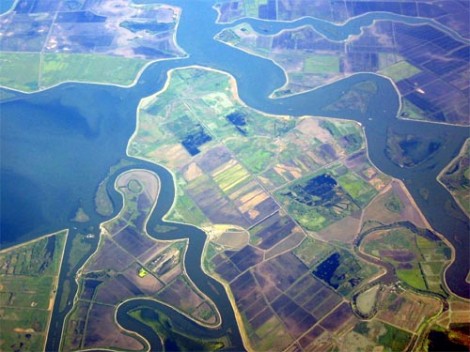
At the center of this epic water grab is the Sacramento-San Joaquin Delta, a Yosemite-sized patchwork of waterways and farmland an hour east of Oakland that sits atop California’s single largest water source. Formed by the confluence of state’s two largest rivers as they flow out to the San Francisco Bay, more than half of all rainfall and snowmelt drains through the Delta, supplying two-thirds of California with water and irrigating most of the state’s farmland. The Delta’s agricultural, fishing and tourism industries produce up $5 billion in combined economic output a year, and the region remains one of California’s last holdouts of small and family farms. It is also home to the most dangerous flood control system in America.
“Now we realize it may be the single most at-risk piece of property in the United States,” John Radke, a professor at UC Berkeley’s Department of City and Regional Planning, told Emergency Management magazine. “If you had a catastrophic event there and you can’t get things built, you won’t just have people unable to go across a bridge, you’ll have people without drinking water — 22 million of them.”
A simulation carried out by state water officials in 2005 showed that a 6.7 magnitude earthquake could cause multiple levee breeches that would suck salt water in from the San Francisco Bay and shut down the pumps and aqueducts that move drinking water to two-thirds of California’s population. The California Department of Water and Power estimates that it would take $40 billion and 1.5 years to get the water pumping again. Aside from the potential damage to the state’s water supplies, the levees protect 400,000 people, 520,000 acres of farmland, three state highways, railroad lines and natural gas and electric transmission facilities, which adds up to a total of $50 billion worth of property. Meanwhile, the United States Geological Service estimates a 62 percent probability such an earthquake will hit the San Francisco Bay Area sometime in the next 28 years.
With Southern California depending on Delta water for over half of its total supply, you don’t need to be a municipal planner to realize how hairy the situation could get.
“Los Angeles’ aqueducts, viewed through telescopes from space, have given astronauts pause. If the contrived flow of water should somehow just stop, California’s economy, which was worth about a trillion dollars as the new millennium dawned, would implode like a neutron star,” wrote water historian Marc Reisner in his unfinished book, A Dangerous Place, describing a potential Delta catastrophe.
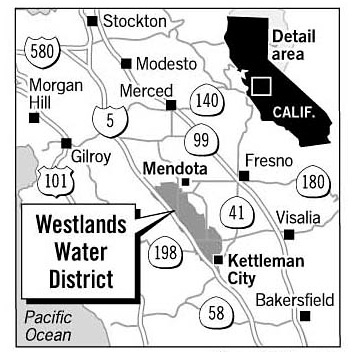
Yet one group that might be anticipating this disaster is a tiny cabal of billionaire farmers from the Westlands Water District, an irrigated farming region spanning 1,000 square miles of some of the hottest, most arid land in the San Joaquin Valley between Fresno and Bakersfield. “With crops worth $1 billion a year, this one district produces more than some whole states,” writes Mark Grossi of the Fresno Bee. The farmers in the district make up a secretive old boys’ network that has used its wealth and power to divert rivers, empty lakes, plunder taxpayers’ wealth, privatize water and defy California’s constitution. Many of them trace their roots back to the landholdings of America’s most notorious industrialist vampires: the Union Pacific Railroad octopus, John D. Rockefeller’s Standard Oil and the family of Los Angeles Times‘ publisher Harry Chandler. The 19th century robber barons might be dead, but their degenerate grandchildren are still following in their footsteps. And they’ve been keeping themselves busy.
In the 1960s, after Westlands’ farmers thoroughly tapped out their own groundwater supplies, the irrigation district successfully lobbied the federal government for its very own branch of the Central Valley Project aqueduct, which would suck water out of the Delta and transport it roughly 100 miles south. Westlands still hasn’t paid back the roughly $500 million it owes the federal government for building the aqueduct, and it’s not clear if it ever will .
More recently, with George W. Bush in the White House, Westlands farmers pulled a few strings and installed their former lobbyist, Jason Peltier, into a spot in the Interior Department, where he would oversee water contracts — exactly the kind Westlands depended on for its wealth. Not surprisingly, in 2005, the district farmers were able to double their annual maximum allotment of federally-subsidized water, despite a reduction in the number of acres they farmed. Today, they have a contract for more water than would be used by all the people who live in Los Angeles, San Francisco, San Diego, Riverside and San Bernardino combined, paying roughly $50 million for at $0.5 to $1 billion worth of water a year, according to the Environmental Working Group.
By some estimates, every dollar of revenue from Westlands’ farms is funded by 75 cents’ worth of water subsidies alone.
“W” is for “welfare”: two generations of money-grubbing farmers from the Woolf family
Who gets all that liquid capital? Farmers like Stuart Woolf, a typical specimen of a Westlands welfare queen. The Woolf family operates the “biggest farming operation in Fresno County,” receiving $4.2 million annually in subsidized water — enough to supply a city of 150,000 people — and Stuart Woolf alone got roughly $8 million in federal crop subsidies over the past decade. Yet, he recently appeared on 60 Minutes, pretending to be a struggling farmer who’s dying of thirst because government regulations enacted by big city elitists to protect some worthless little fish are cutting into his water supplies. In 2008, he did what any small farmer would do to defend his livelihood: he threatened a congressional subcommittee that he’d move his family’s farm holdings to Portugal, Spain, Turkey and even China if the feds didn’t give him more taxpayer-subsidized water.
But for all the money taxpayers have sunk into keeping Westlands farmers rich and in business, they don’t get much back. Not only does the irrigation district contribute a pitiful 0.5% to California’s gross state product, but it also occupies the poorest congressional district in America, according to a 2009 report by Lloyd G. Carter, a veteran UPI reporter who has covered California’s farming industry for three decades, which details the history of Westlands. The district is rife with poverty, illiteracy, teen pregnancies, and a high incidence of birth defects caused by all sorts of toxic agricultural pollution. There’s not a single school within its 1,000-square mile borders because its farmers only care about one thing: keeping themselves rich at other people’s expense.
But for all their power, there it still something that keeps Westlands farmers up at night.
“If you don’t have water, this land is not worth anything,” Erik Hansen, another Westlands farmer who received over $13 million in federal crop and water subsidies over the past decade, told a Central Valley newspaper.
Westlands may have managed to secure mind-boggling amounts of water from the federal government, but these contracts are far from secure. Unlike farmers in the Delta region, who are located right next to their water source, Westlands growers are dependent on a aqueduct system that ships their water from about 100 miles away. That means they are last in the water line and first to be affected by any water shortages: too may straws dipped into a shrinking supply upstream creates the very real possibility that Westlands and their oligarch buddies might wake up to a bone dry aqueduct, while Delta farmers would be playing the slip ‘n slide.
And that drives Westlands up the wall. Not only do Delta farmers, who are poorer and less politically connected, have first dibs on Delta water, but they also sit on a whole lot of untapped available fresh water. By conservative estimates, at least $5 billion worth of water flows through the Delta every year. Much of it is captured for local consumption and shipment south, but about half of the water is allowed to flow out into the San Francisco Bay unexploited. In water lingo, it’s called “environmental outflow” and it is required to keep the Delta’s ecosystem healthy and protect its farmland. The exact volume of water budgeted for environmental outflow has been tempered by lawsuits and is regulated by environmental protection laws.
To Westlands and their billionaire buddies, this represents a blatant waste of a perfectly good resource and provides a textbook example of the inefficiency that creeps in when regulation hinders free-market forces. They look at the Delta the same way a condominium developer looks at a run-down housing project occupying prime inner-city real estate: an underutilized resource that needs to be razed and privatized. The Delta’s small-time farmers are the only thing standing in their way, and its crumbling levees are the perfect excuse to get them out.
The Delicate Delta
On June 3, 2004, without warning and for no apparent reason, a 300-ft. crack opened up in a levee protecting 12,000 acres of Delta farmland, where 15 landowners grew alfalfa, corn, asparagus, tomatoes and wheat. The water surged into the island at a walk’s pace as people rushed to rescue equipment, evacuate workers and save harvested crops. Within the next two days, an area half the size of San Francisco was submerged under 10 feet of water, causing $100 million in damage. This was not an isolated incident; there have been 160 levee breeches over the past 100 years.
The levees have been a constant problem since the 19th century, when failed prospectors moved to the Delta after the Gold Rush, drained chunks of marshlands, buffered them with earthen levees and turned the region into the most productive agricultural area in California. Over time, the pressures on the levees have only increased, as farming has slowly eroded the rich, fluffy peat soil of the Delta and sunk its land deeper and deeper below sea level. And while the rate has slowed down considerably, Delta farmland has by now been turned into a series of inverted islands — holes, really — that sit as much as 30 feet below sea level. The only thing keeping them from being inundated with salt water from nearby San Francisco Bay is a chaotic flood control system that spans over 1,000 miles of levees, many of which are little more than reinforced mounds of dirt that were piled up by Chinese laborers 100 years ago. Hundreds of miles of levees aren’t up to state and federal code, and many experts believe that the levees are woefully outdated, unstable and primed for catastrophic failure. They could be liquefied by an earthquake, eroded from the inside by undetected water seepage or simply overwhelmed during heavy flooding.
The problem has been known for decades, and the estimated cost of fixing the levees is not particularly high — between $1 and $5 billion — but the issue just never figured high on the political agenda. California saw a whole legion of governors — Jerry Brown, Pete Wilson, Gray Davis and now Schwarzenegger — cycle through without giving it much attention.
“The state has never taken any responsibility for having a flood management program in the San Joaquin River system and has not exercised the same responsibilities that it is by law required to exercise in the Sacramento system and the North Delta,” Alex Hildebrand, a Delta farmer, told California’s Farm Bureau Federation, a non-profit that promotes the state’s agricultural interests, a year after Hurricane Katrina.
The Delta may still enjoy some the most fertile soil in America and remains a highly prosperous agricultural region, producing about $500 million worth of crops annually, but as one of California’s last holdouts of small and family farms, the region has never had very much political clout. And that has been the region’s biggest weakness, more so than even its levees.
While powerful Central Valley farmers have been enjoying billions of dollars’ worth of dams, aqueducts and all sorts of other subsidized goodies, the Delta has been surviving on the most meager of funds, barely having enough for rudimentary and critical levee repairs. Throughout the 80s, the Delta got 1/10th of the funds Westlands received in water subsidies alone. And the situation is not any better today. California’s recent budget crisis has all but cut off funding for levee repair projects, wrote the Sacramento Bee in 2009. “As a result, almost no levee repairs are getting done in the Delta this year. One levee engineer told The Bee as much as 15 miles of levee repairs have been stalled. Any of these levee segments could become the next failure that plunges the state into an even more desperate water crisis.” The funding freeze has left an additional 100 miles of levees and 60 Delta islands hanging in the balance. Local officials say that they won’t have the money to perform preventative maintenance for at least the next two years.
“I sympathize, but at this point in time the funding is not available because of the dire situation we are in,” Mike Mirmazaheri, who manages the Delta levees program for California’s Department of Water Resources, told the Sacramento Bee. But it is hard to pin the blame on the economy. Because while the Golden State turns out its pockets and makes a sad face when it comes to Delta funding, money never seems to be a problem when it comes to bankrolling projects that benefit billionaire farmers of the Central Valley.
And that begs the question: Why does California let the most critical component of its water delivery system deteriorate?
The Peripheral Canal
It’s all about the Peripheral Canal, a massive, multi-billion dollar aqueduct that would bypass the Delta region altogether and tap into the Sacramento-San Joaquin River further upstream, essentially allowing corporate farmers and Southern California’s real estate tycoons to cut to the front of the Delta water line and have direct access to Northern California’s water. Any major levee repairs would squelch one of the main reasons — water safety — being used to justify the construction of the aqueduct, which would cost up to $40 billion and require the use of eminent domain to clear the path for its 50-mile run up north from pumping stations at the southern end of the Delta to the southern border of Sacramento.
The Peripheral Canal is more than just about cutting Delta farmers out of the game and taking their water. It is part of a bigger, more long-term strategy by a handful of farmers and urban water districts to lay down infrastructure that would enable the creation of a full-fledged “water market” that would allow them to acquire and sell Northern California’s water to the highest bidder, like any other commodity.
Southern California been trying to pull this scam off for decades. The last time was in the late 70s and early 80s, when Governor Jerry Brown tried to push the Peripheral Canal through for his Southern California real estate buddies. But the plan failed after wealthy Central Valley farmers threw their support behind a coalition of environmentalists and Northern California water districts to defeat the project. It’s not that the billionaire farmers were against the the Peripheral canal — they simply feared that Southern California real estate developers were trying to pull a fast one on them and cut them out of the water racket.
Now, three decades later, the two parties have appeared to come to terms everyone could agree on. The details are opaque, but word out on the street among Delta water activists is that the deal comes down to this: Westlands and their billionaire farmer buddies will team up with Southern California real estate developers if all water transfers from the Delta first go through them. That way, the farmers would become the de facto middlemen in California’s water market, harvesting subsidized water from the Delta at below-market cost, storing it in their vast underground water reservoirs and then flipping it to Southern California cities and suburbs for a massive profit. This has been a dream of California’s water interests, and exactly the future that Enron was working towards when it set up its own water trading company in California at the height of the dot-com bubble.
California’s water oligarchy has been doing this on a small scale for years, according to a 2005 Public Citizen’s report called “Water for the People“:
The immense pull of the Southern California’s population, economy and property values has already created the most complex and farthest reaching system of aqueducts and canals in the United States. Now Southern California water managers are using that plumbing to pull in water from the farmers and agribusinesses across the state who have themselves benefited from decades of water subsidies. Some call this water marketing: Southern California tax and ratepayers making payments to some of the largest agribusinesses in the state, many owned by LA businessmen, for water that supposedly belongs to the public in the first place.
With the Peripheral Canal, they’d be able to do it bigger, better and more “efficiently.”
To pull it off, California’s politicians and their billionaire backers have seemingly upped the ante from their last Peripheral Canal push in the 80s, using all the fear-mongering they could muster. And if anything could scare California into paying for a multibillion dollar aqueduct, then the real and present danger of the state suddenly losing most of its water supply is it.
“This is a blatant attempt to steal Northern California’s water,” Lloyd G. Carter told me over the telephone.
Does that mean billionaire farmers and Southern California real estate developers have been actively plotting to destroy the Delta?
While there might be no direct evidence of a conspiracy, looking at the successful water deregulation and privatization schemes pushed through behind closed doors by wealthy corporate farmers in the past two decades, the idea does not seem very outlandish or even improbable. Besides, this wouldn’t be the first time a group of powerful Californians pulled off a sneaky water grab, including destroying a poor agricultural region hundreds of miles away in order to feed urban growth and moneyed interests.
For instance, take Los Angeles’ turn-of-the-last-century water plunder from the Owens Valley, located 250 miles away in the Sierra Nevadas. In what must be the most famous water heist in American history (and the inspiration for the movie Chinatown), L.A.’s founding fathers — including Los Angeles Times owners Gray Otis and Harry Chandler — engineered a monstrous swindle that ripped off just about everyone in Southern California in order to make themselves unbelievably rich off of real estate speculation. Not only did they scam locals farmers, turn a beautiful mountain valley into a desert wasteland and fake a drought back in L.A. to convince the population that building an aqueduct to siphon off Owens Valley water was a matter of life and death worthy of issuing a pricey bond, but they secretly sent the plundered Owens Valley water — not to Los Angeles, which was supposed to be dying of drought — but to nearby San Fernando Valley, where a group of insiders had bought up worthless, dry farmland on the sly, knowing full well that a whole lot of water was about to be coming their way. The scam made a handful of people mind-bogglingly rich, and it was decades before anyone got wise to the full story of what happened.
You could see plenty of shady, conspiratorial forces at work after Governor Arnold Schwarzenegger convened the Delta Vision Blue Ribbon Task Force in 2006. On paper, the task force was created to come up with a solution to the Delta’s levee problems. In reality, it was a thinly veiled PR job tasked with finding a way to sell the Peripheral Canal to an unsuspecting public. Its members represented the real estate industry, Southern California’s urban interests, wealthy corporate farmers from the Central Valley, real estate developers, construction companies and just anyone else who stood to profit from a massive diversion of Northern California water. The only group not represented were the people who actually lived, worked and farmed in the Delta. Not surprisingly, the prevailing attitude of the committee was that the Delta was a dangerous, polluted stink-hole not worth saving.
“Colonize the Delta,” is what Barbara Barrigan-Parrilla, campaign director for Restore the Delta, a grassroots organization representing the Delta’s interests, told me locals call the solutions coming out of the governor’s Delta Vision task force. Its only purpose was to find a palatable way to push through the Peripheral Canal. “I was shocked at the open hostility towards the Delta by Central Valley farmers.” Describing a task force meeting she attended in Los Angeles in 2006, she said the people running the show were not keen on discussing the possibility of major levee repairs and modifications. About the only thing its delegates were interested in discussing was how much it would take to buy out all the Delta landowners so they’d quit their bitching and turn over their water rights.
To help the task force move along, all sorts of powerful interests came out of the woodwork, helping shape public opinion and influence policy decisions.
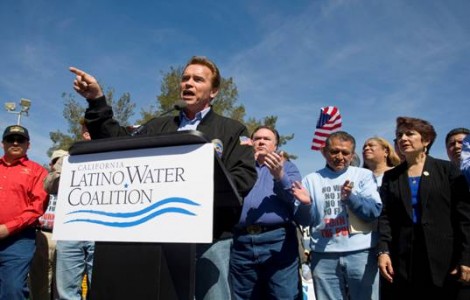
Central Valley farmers set up and bankrolled various astroturf organizations, mobilizing them with one goal in mind: to make the Delta appear doomed and harmful to California, while selling the Peripheral Canal as California’s only route to water salvation. One of the groups, Coalition for a Sustainable Delta, was set up by high-ranking employees of Paramount Farms, the massive agribusiness owned Beverly Hills billionaire Stewart Resnick, the brain behind a recent water privatization scheme. Another group was run out of an Orange County real estate PR, which counted at least one large Westlands farmers as its client. A third, called the Latino Water Coalition, was not only heavily promoted by third-rate Fox News correspondent Sean Hannity, but was set up and run with taxpayer money and blessed by the Gov. Schwarzenegger himself.
Reports and simulations put out by California’s water officials suddenly started pimping the Delta’s levee threat for all that it was worth, prompting accusations from Delta politicians that Sacramento was exaggerating the danger to help push through the Peripheral Canal. A politician from Stockton called the whole thing a “manufactured crisis.”
In 2008, the Public Policy Institute of California (PPIC), a pro-billionaire think tank working out of UC Davis, came out with a secret weapon that shocked and awed Delta farmers and helped seal the deal for a Peripheral Canal. According to the PPIC, the Delta was beyond repair and that the best way to save it was to preemptively drown it — give it a dignified Kevorkian, if you will — and build the Peripheral Canal. It was exactly the kind of science-based boost Schwarzenegger’s task force desperately needed to add credibility to its Peripheral Canal plans — even Westlands’ general manager began to quote it at length.
The report came under fire for its extreme bias against the Delta. Critics charged that it blew the Delta’s problems out of proportion, downplayed the cost of the aqueduct and overestimated the cost and difficulty of levee upgrades. Even more disturbing was the way it elevated the needs of rich corporate farmers in the Central Valley above those of smaller family farms up north. To Delta farmers, this was an outright declaration of war upon their lands and livelihoods. “I feel like a lamb surrounded by wolves, and every time you turn to deal with one, another one is nipping at you,” a Delta farmer told the San Francisco Chronicle. “This isn’t just a wilderness out there,” another farmer told the Stockton Record. “There are people. Farmers.”
It was probably a coincidence that the think tank was being bankrolled by the Bechtel family, which not only owns the the largest engineering company in America but is also a huge proponent of water privatization. Bechtel would not only benefit from the construction of a massive canal — as it is precisely one of the few companies in the US able to handle these kinds of projects — but from a major levee breech as well, as it did in New Orleans when the company was awarded a few million dollars’ worth of no-bid contracts to build temporary housing.
Whatever the case, in November 2009, Schwarzenegger signed off on a massive $11.3 billion water reform package aimed at improving and reforming California’s aqueducts that will hit voting booths in the upcoming November 2010 mid-term elections. Aside from deregulating California’s water market even more and removing all groundwater pumping limits, the measure contains cryptic language outlining the creation of a special new commission, the Delta Stewardship Council, that would do an end-run around the democratic process, giving it the extraordinary power to authorize massive water projects like the Peripheral Canal without requiring a referendum by voters. With this kind of language in place, California’s water oligarchs could do dirty privatization chicken dance all on their own, without needing to dupe the state’s voters. And that’s a good thing, because democracy has never sat well with America’s billionaire class.
“It was awful, incredibly awful. I’ve never seen anything like this,” California state Senator Lois Wolk, who represents the heart of the Delta region, told the Stockton Record, adding that Los Angeles’ Metropolitan Water District and Westlands wrote the bond measure “in private meetings, and then it emerged in the middle of the night.”
It is far from certain whether voters will fall for the scam come November, but one thing is clear: unlike previous times, the fear-mongering involved in this push for the Peripheral Canal is not just about PR and media manipulation. The doom scenario is a very real possibility, and that is what makes it so sinister. Because nothing would get the Peripheral Canal built faster — and satisfy California’s water oligarchy more — than a massive levee failure in the Sacramento-San Joaquin Delta.
***
Yasha Levine is a mobile home inhabitin’ editor of The eXiled. He is currently stationed in Victorville, CA. You can reach him at levine [at] exiledonline.com. Further reading: How Limousine Liberals, Oligarch Farmers and even Sean Hannity Are Hijacking Our Water Supply. And check out the rest of Levine’s “water wars” coverage...
This story was first published on Alternet.org
Read more: california, drought, Schwarzenegger, the delta, water, Water Wars, Yasha Levine, Water Wars


Got something to say to us? Then send us a letter.
Want us to stick around? Donate to The eXiled.
Twitter twerps can follow us at twitter.com/exiledonline






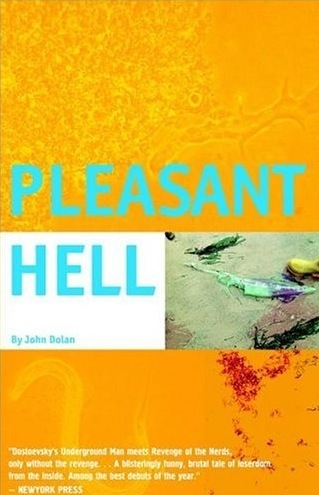

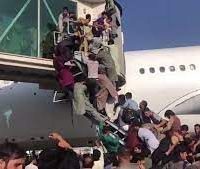
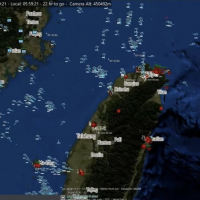






20 Comments
Add your own1. matt | March 23rd, 2010 at 9:51 am
Shit that was good.
2. Commoncents | March 23rd, 2010 at 2:28 pm
Fantastic read. The reality that money drives politics to nth degree is frightening and media’s participation is nothing short of treason.
3. eric | March 23rd, 2010 at 2:35 pm
You see, Mr. Levine, most people never have to face the fact that at the right time and the right place, they’re capable of ANYTHING.
4. matt | March 23rd, 2010 at 3:56 pm
sweet, originally read at alternet. but liked the pics to compliment it.
5. Coke-n-acid | March 23rd, 2010 at 7:29 pm
too long. couldn’t finish in two days.
6. dsjdhsjkahdsand | March 23rd, 2010 at 11:33 pm
a good read.
7. More evidence | March 24th, 2010 at 10:40 am
Yasha/Mark:
The Contra Costa Times did a series on the Redwood City Saltworks development earlier this month, as an example of how the water rights are going to be redirected to connected developers while the billionaire thugs you identified profit.
“DMB Associates, an Arizona-based company that specializes in upscale mixed-use developments close to wilderness, plans to pipe 591 million gallons per year from the Sacramento-San Joaquin River Delta to as many as 12,000 homes on the Redwood City Saltworks site via a series of complicated and unprecedented water exchanges that originate 300 miles to the southeast in Kern County.”
See http://www.contracostatimes.com/top-stories/ci_14474531
and
http://www.contracostatimes.com/top-stories/ci_14489119
8. jason | March 24th, 2010 at 11:04 am
Fascinating. And here I was pulling for Central Valley farmers. Also interesting in the face of increased water allocations by the Feds to Central Valley farmers (http://sacramento.bizjournals.com/sacramento/stories/2010/03/15/daily31.html), possibly in exchange for yes votes on Healthcare by the two local Congressmen.
I don’t understand why CA has to foot the bill for repairing the levees in the Sac River Delta. I thought that was all Federal owned and managed?
9. jason | March 24th, 2010 at 11:11 am
Throw in this interesting tidbit about where the Westlands “oligarchs” stand in the current water heirarchy, http://articles.latimes.com/2010/mar/14/business/la-fi-hiltzik14-2010mar14
10. Antonio B. | March 24th, 2010 at 12:16 pm
Do something about those grammatical errors damn it!
11. John | March 24th, 2010 at 2:22 pm
Nice article, Yasha. So what are the chances you get knocked off, or get a little visit from a couple of thugs to keep your mouth shut?
12. bobjones | March 24th, 2010 at 5:52 pm
let the gang stalking begin
13. Kat | March 26th, 2010 at 8:14 am
I wish that your stuff was seen by a larger audience.
14. Hosswire | March 26th, 2010 at 5:07 pm
Forget it, Yasha. It’s Chinatown.
15. HS | March 28th, 2010 at 6:02 pm
Good article, its very interesting how it shows how the rich use government subsidies to screw over the rest of us. The only problem is how the statement about turning the water into a good traded on the market clashes with the rest of the article. See I know best: if water was a resource traded on the open market, and there weren’t 75 cents in subsidies for every dollar in profits, how long would those bastards last? They’d be fucked. I mean all those rich Chinamen and Saudi Arabian prices could pay WAY more for water than broke ass people in Los Angeles.
See, I like Chinamen—Thai Boys, actually—so I know best.
16. FrankMcG | March 31st, 2010 at 1:07 am
The “how much is enough” line from Chinatown pretty much sums it up. I think that at the very least we all can understand the temptation of doing something questionable to get rich.
But when you’re already so mega rich that you could live a seven figure lifestyle on the interest alone? What king of mind does it take to continue screwing people over for money at that point?
17. Mx? | April 1st, 2010 at 4:46 pm
Hmmm that´s kinda like the narcos in Mexico using SAGARPA goverment agricultural subsidies to invest in growing better crops of weed in the sierras of Sinaloa.
Theyre not so different, our capos and your CEOs, but I think that because CEOs think their actions are legal or even above it that makes them worse, at least narcos have the decency of killing each other at opportunity they have.
18. tigre | April 14th, 2010 at 11:09 am
Hey Yasha- I don’t know where you get your numbers, but as an Owens Valley resident you can use $800 an acre foot to calculate the wholesale cost of water.
That’s how much LADWP pays the Metropolitan Water District for Water.
19. tigre | April 14th, 2010 at 11:21 am
Oh yeah- the Owens Valley isn’t as bad as people say.
The Owens Dry Lake is an eyesore that spews unhealthy dust into the air, but court ordered dust control measures have reduced the dust quite a bit.
Another court order forced DWP to put water back into the Lower Stretch of the Owens River. Another stretch had to be re-watered in the 80’s.
Groundwater pumping remains and issue, major springs have been destroyed by the pumps, but there is a lot here that is intact.
20. Fleshbug1 | February 2nd, 2011 at 2:54 pm
…well this is a few years after the last post.I was just snooping the web for water privatization bullshit. Regrettably,bullshit, right from the get go.Things have only become much(x2) worse since this awful article. See you in the Revolt that is way past-due…
Leave a Comment
(Open to all. Comments can and will be censored at whim and without warning.)
Subscribe to the comments via RSS Feed